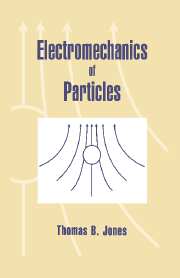Book contents
- Frontmatter
- Contents
- Preface
- Nomenclature
- 1 Introduction
- 2 Fundamentals
- 3 Dielectrophoresis and magnetophoresis
- 4 Particle rotation
- 5 Orientation of nonspherical particles
- 6 Theory of particle chains
- 7 Force interactions between particles
- Appendix A Analogies between electrostatic, conduction, and magnetostatic problems
- Appendix B Review of linear multipoles
- Appendix C Models for layered spherical particles
- Appendix D Transient response of ohmic dielectric sphere to a suddenly applied DC electric field
- Appendix E Relationship of DEP and ROT spectra
- Appendix F General multipolar theory
- Appendix G Induced effective moment of dielectric ellipsoid
- References
- Index
3 - Dielectrophoresis and magnetophoresis
Published online by Cambridge University Press: 02 December 2009
- Frontmatter
- Contents
- Preface
- Nomenclature
- 1 Introduction
- 2 Fundamentals
- 3 Dielectrophoresis and magnetophoresis
- 4 Particle rotation
- 5 Orientation of nonspherical particles
- 6 Theory of particle chains
- 7 Force interactions between particles
- Appendix A Analogies between electrostatic, conduction, and magnetostatic problems
- Appendix B Review of linear multipoles
- Appendix C Models for layered spherical particles
- Appendix D Transient response of ohmic dielectric sphere to a suddenly applied DC electric field
- Appendix E Relationship of DEP and ROT spectra
- Appendix F General multipolar theory
- Appendix G Induced effective moment of dielectric ellipsoid
- References
- Index
Summary
Introduction
In the last chapter, we used a dipole model to provide a physical interpretation for the forces and torques exerted upon small particles by an electric field. An effective moment methodology was advanced for calculation of the dipole and higher-order multipolar forces. We extended this method to heterogeneous particles, that is, concentrically layered spherical shells, and to particles with dielectric and/or ohmic losses. With this necessary modeling framework now at our disposal, we direct our attention to the phenomenology of dielectrophoresis. Dielectrophoresis (DEP) refers to the force exerted on the induced dipole moment of an uncharged dielectric and/or conductive particle by a nonuniform electric field. This book's early focus on DEP serves as acknowledgment that the dipole force term predominates over higher-order multipolar components in the electromechanics of particles except in the case of a particle located near a field null or in the strongly nonuniform electric field of another closely spaced particle. Dielectrophoresis is technologically important in its own right, as evidenced by the number of applications in such scientific and technical fields as biophysics, bioengineering, electrorheological fluids, and mineral separation.
Electromechanical forces are exerted upon magnetic particles in a nonuniform magnetic field as well. This phenomenon, called magnetophoresis (MAP), is to some extent analogous to dielectrophoresis; however, because of the nonlinearity exhibited by most magnetic materials and the effectively diamagnetic behavior of (i) conductive particles in AC magnetic fields and (ii) superconductive particles in DC magnetic fields, there are some important differences. For these reasons, we treat the subject of magnetophoresis separately in Section 3.5 and highlight certain limitations of the dielectric–magnetic analogy.
- Type
- Chapter
- Information
- Electromechanics of Particles , pp. 34 - 82Publisher: Cambridge University PressPrint publication year: 1995
- 25
- Cited by



